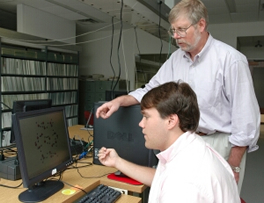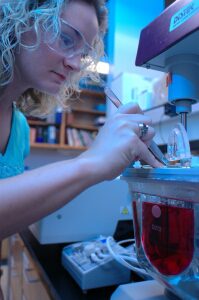From B-boying to Fuel Cells, Gaming to Cancer Medication, UA Undergraduates Further the Institution’s Mission Through Groundbreaking Research

Don’t call him a break dancer; Wesley Nixon is a b-boy.
While the ‘b’ does originate from the word break, it’s considered to some an insult to call it break dancing, a term coined by the media in the 1980s.
“It’s an understudied topic,” Nixon said. “The dance may seem a little strange to some, but it has meaning behind it. B-boying is an expression of identity and culture.”
Nixon explored the debatable history of the dance form and interviewed b-boys and a b-girl in Alabama and Georgia to more fully understand this art form from the perspectives of the people who practice it. He concentrated on the b-boys’ understanding of the history of the dance and their respective influences and introductions.
One of his research advisers, Dr. Marysia Galbraith, associate professor of New College and anthropology at The University of Alabama, believes Nixon’s background as a b-boy helped him with his study. “He had unique access as a b-boy,” Galbraith says. “He knew what questions to ask, and it was easy to approach them. Wesley made good use of qualitative material.”
With little previous research on the topic, Nixon believes his study will be a base for further anthropological research.
“In the course of his study, he became acquainted with a leading anthropologist of dance at Indiana University,” said Dr. Nancy Campbell, manager of the McNair Scholars Program at UA. “He will be studying with her at IU for his doctorate after completing his master’s degree at Oregon State University.”
Nixon conducted his research as part of the McNair Scholars Program, a prestigious scholarship and research program that helps prepare accomplished undergraduates for graduate study. He was one of many at The University of Alabama who conduct groundbreaking research before they earn their bachelor’s degrees.
“Undergraduate research is widely considered a ‘best practice’ in higher education,” said Campbell. “Students learn to not only be consumers but also producers of knowledge.”
Payouts

Education has long been important to Karla Martin, who is also a McNair Scholar. She attended The University of Alabama so that she could educate others as an elementary school teacher.
Martin is a member of the Poarch Band of Creek Indians, the only federally recognized tribe in the state of Alabama. The tribe has three newly established gaming facilities, generating revenue that is being divided among different programs, one of which is education.
“There’s lots of money coming in, and I’m an advocate for education,” Martin said. “But I want to help make sure that the money is going toward the right benefits.”
Statistics show Native Americans lag far behind the rest of the country in education, with the highest high school drop-out rate and a low percentage of college graduates.
She examined some of the United Southeastern Tribes with gaming to analyze the impact that gaming has had on the quality of their respective tribe’s education. While most tribes studied provide scholarships for traditional-aged college students, Martin suggests, after analyzing the research results, tribes consider providing educational funds to members of all ages.
“Karla’s research is important in that it addresses a serious social and educational issue,” Campbell said. “Her research yielded insights to share with the Poarch Creek Indians as well as other Native Americans as they plan for the financial and educational needs of tribal members.”
The big picture

Jacob Batson is no stranger to scientific research. As an undergraduate, he has worked on several projects while at UA, varying in subject from diabetes to fuel cells.
One of Batson’s research projects focuses on the development of new materials to store hydrogen and release it under controlled conditions so that hydrogen is never stored at a high pressure in a complex tank. This kind of storage is needed as hydrogen-based fuel cells become a possibility.
“My father, who is a professor, always taught us to conserve energy, and this project seemed innovative and growing,” said Batson, a student in the College of Arts and Sciences. “I could see the impact it would have in the future to help people practically.”
Batson’s research is a big effort that is part of an even bigger project, sponsored by the U.S. Department of Energy. He builds 3-D models on a computer of proposed molecular structures. The models then are transferred to an XDI supercomputer in Huntsville, where fundamental physical equations are solved to predict the properties of the molecules. Promising molecular systems can then be tested in various labs, nationwide, that are participants in the collaborative project. Dr. David Dixon, Ramsey Chair of Chemistry, said that Batson’s work as an undergraduate at UA “is leading us in new directions as how to store hydrogen in chemical systems.”
Important groundwork

Marla Hampel is also working on a bigger picture project. She has conducted research on novel polymer systems that will be used to target cancer cells and release medication locally to cancer cells.
Hampel had a direct experience with UA during her high school years, as a participant in the UA program known as SITE, or Student Introduction to Engineering. The program is designed specifically for rising high school juniors and seniors interested in math, science and engineering. “I’ve always liked chemistry and am good at math, so chemical engineering is a natural fit for me.”
As an undergraduate at UA working with Dr. Chris Brazel, associate professor of chemical and biological engineering, Hampel developed thermally responsive polymers with imbedded magnetic nanoparticles, and investigated its changes. The research should have a major impact on cancer therapies, including reducing side effects associated with chemotherapy and treating previously inoperable cancers.
“We’ll be able to give some people hope and make lives better,” Hampel said. “It’s sometimes hard to see that working in a lab, but deep down, you know it.”
Further Reading